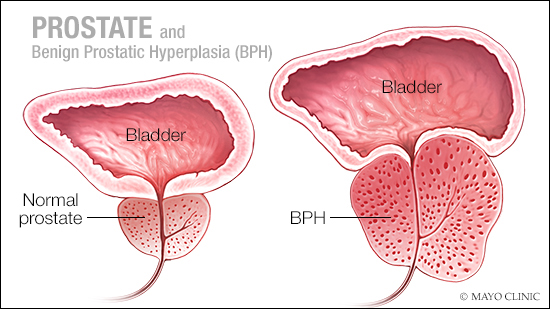-
Featured News
Mayo Clinic Q and A: What are your options for managing BPH?

DEAR MAYO CLINIC: Recently, I was diagnosed with BPH. This is all new to me, and I hope you can help me better understand the condition and how it's treated.
ANSWER: Now that you've been diagnosed with benign prostatic hyperplasia (BPH) — noncancerous tissue growth within the prostate — it's time for you and your healthcare team to talk about treatment options.
These options depend on the severity of your symptoms, which can range from having a weak urine stream to not being able to urinate at all. Most treatments are done in the outpatient setting, including your clinician's office, while others may require a hospital stay. Wherever you are on the range of symptoms, there are treatment options that can relieve them, including:

Behavior modifications
If you're experiencing bothersome, but not severe, symptoms, such as having a weak urine stream or frequently getting up at night to urinate, your treatment may start with:
- Changes to your diet
Some foods, such as chocolate, citrus, carbonated beverages and caffeine, can irritate your bladder, which can increase your urge to urinate. Cutting back on these foods may ease your symptoms. - Fluid intake
Reducing the amount of fluid you drink before bedtime can decrease your need to urinate during the night. - Timed urination (voiding)
Holding your urine can also irritate your bladder, so making a point to urinate every hour and a half to two hours can reduce the urge to go "now."
Medications for BPH
If these behavior modifications are no longer effective, your clinician may prescribe a medication, which you'll need to take every day. These include:
- Alpha blockers
These drugs relax muscles in the bladder and prostate, and they open up the urinary channel to reduce blockage. Side effects include a decrease in blood pressure, dizziness and lightheadedness. They also can cause semen to go back into the bladder instead of the penis, which may be startling, but is harmless. - 5-alpha reductase inhibitors
These medications work to shrink the prostate by lowering the production of a specific hormone. There are more side effects, and it may take six to nine months to see any results. Men may have a lower sex drive, and some will experience erectile dysfunction.
Surgical procedures
You and your healthcare team may decide that in-office therapies or surgery to shrink or remove overgrown prostate tissue would be the best treatment option for you. Some treatments work better than others, depending on your symptoms, treatment goals and the size of your prostate. Most preserve sexual function and have little or no effect on erectile or ejaculatory function.
These treatments include:
- Temporarily implanted nitinol device
This procedure reshapes the tissue of the prostatic urethra and the bladder neck to create a wider channel through which urine can flow. A narrow, folded nickel titanium device is inserted into the prostatic urethra. As the device expands, gentle pressure reshapes the urethra and bladder opening. After five to seven days, the device is removed. - Prostatic urethral lift (PUL)
This procedure reshapes the prostate using a small, permanent implant to compress and lift the side of the enlarged prostate to increase the urethra opening. - Steam therapy
During the treatment, a tiny needle is inserted into the urethra and positioned in the prostate gland. In nine seconds, the needle produces a 2-centimeter-wide steam ball that shrinks the surrounding prostate tissue. - Transurethral resection of the prostate (TURP) and photo-selective vaporization (PVP)
During a TURP, a lighted scope is inserted into the urethra and the surgeon uses an electric loop to remove all but the outer part of the prostate. TURP generally relieves symptoms quickly, and most men have a stronger urine flow soon after the procedure.
PVP is laser therapy performed in an operating room under anesthesia. A surgeon inserts a thin, tube-like instrument into the urethra. This instrument has a lens, light and tool that sends out an electrical current to destroy prostate tissue. Heat from the current seals small blood vessels, reducing the risk of bleeding. This procedure destroys or removes overgrown prostate tissue and is a good choice if you need to stay on blood thinners.
- Prostate enucleation (BipoLEP or HoLEP)
This procedure removes nearly the entire prostate without an incision. It is often a good option for patients with especially large prostates, the inability to stop blood thinners or in significant urinary retention. A thin instrument is inserted into the urethra. Then, a laser cuts the prostate tissue into small, removable pieces. - Simple prostatectomy
This minimally invasive surgery removes tissue blocking the flow of urine. It usually requires a one-night stay in the hospital and is done laparoscopically through a small incision in your side, most often using a surgical robot.
Ross Avant, M.D., Urology, Mayo Clinic Health System, Austin and Red Wing, Minnesota; Mayo Clinic, Rochester, Minnesota







